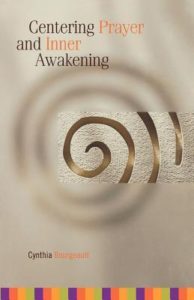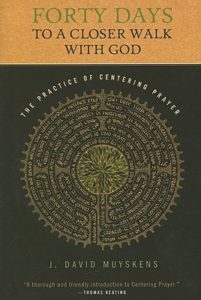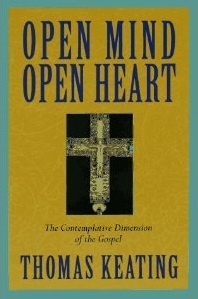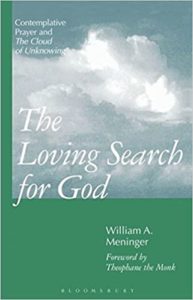Who’s ready for some peace and holy quiet? When I’ve had it with what’s going on in the world around me, I meditate using a method called centering prayer. It differs from the kind of prayer where we say words aloud or silently to ourselves. This prayer relies on silence. By growing quiet to listen intently for God’s voice, we can experience many benefits. So, I offer this to you as one way of finding your peace and your more focused path.
There’s more than one way to pray
Many forms of prayer exist — intercessory (praying for others), using a prayer book or prepared prayer, meditation in various forms, prayer beads, and walking prayers, like using a labyrinth (click here to find one near you). One type is not better than another. In reality, people often use a combination of prayer methods, which I enthusiastically encourage. Different types of prayer resonate with us in different ways. Finding that perfect combination requires trial and error, but such effort produces great rewards.
What kind of prayer is centering prayer?
Centering prayer is a very simple practice that is open to anyone. The centering prayer movement in Christianity today can can be traced to several books published by Trappist monks in the 1970s. (You’ll find a short reading list at the end of this blog.) The name “centering prayer” comes from Thomas Merton’s definition of contemplative prayer, which he described as prayer “centered entirely on the presence of God and His will and love, and as rising up out of the center of nothingness and silence.”
What are the benefits of centering prayer?
The Trappists monks believed that a daily practice of centering prayer could lead to a more intimate connection with God, and a more powerful experience of His presence in our lives. This presence offers healing, transformation, freedom, and greater peace.
Since beginning my own centering prayer practice, I’ve noticed that my patience has increased from having nearly none to having more than I dreamed possible! This shocks my family and friends. I’m not Job, mind you, but I experience greater calm and more openness. When life becomes too much, I know I have to do centering prayer. My mind and heart, and maybe even my body, have learned that I need silence.
By the way, an old adage says that if you think you don’t have enough time to sit in silence with God for 20 minutes, then you need to sit for an hour — this is absolutely true. It means too much noise rules your world.
So give centering prayer a try! You have nothing to lose but chaos.
Centering prayer helps us find our moral compass more readily
In my opinion, centering prayer has helped me get better at reckoning what is righteous, and what is not. I have one goal with centering prayer, and that involves growing close to my Creator.
However, as we grow more anchored in God, we become better at identifying and calling out injustice — God calls us to do that. God calls us to resist evil, expose lies, and end corruption. Essentially, God calls us to name what is wrong in order to right it. God calls us to determine if justice truly exists. When justice is lacking, we must secure it. Spending quiet time with God leads us to clarify what leads to peace, or shalom — wholeness, and what does not.
For us, it is important to stand for something. Otherwise, we stand for nothing. Our sense of integrity depends on our ability to name what violates God’s law of justice and work for justice. And of course, when we succeed in establishing justice, peace arises. Peace yields hope, and hope drives out despair. Naturally, the individual at peace, gathered with others, provides the foundation of justice, peace, and hope of the community, the society, and ultimately, the world.
How can we work toward peace, when we are all immersed in a culture of noise and busy-ness? The essential ingredient to finding peace in our personal lives is prayer.
Practicing centering prayer does not include complicated rituals or movements. You need a comfortable and quiet place to sit. Set a timer on your phone to play a gong or bell to signal the beginning and end of your meditation session. Wear loose fitting clothing. Get comfortable by planting your feet on the floor, flat and even.
The pre-prayer relaxation technique
Try this breathing technique to relax prior to your prayer session. Just a few cycles of this technique have remarkable calming properties.
- Close your mouth.
- Gently place the tip of your tongue behind your top 2 center teeth and hold it there throughout the exercise.
- Now, draw in a breath through your nose for the count of 4.
- Hold for the count of 7.
- Release your breath through your mouth for the count of 8. Throughout this technique, keep your tongue rested behind your two front teeth. It makes a difference, believe me.
- In summary, draw for 4, hold for 7, and release for 8, or 4-7-8.
- Try just two sets to get started. I have found that doing about 4-6 cycles enhances my centering prayer session. I’d like to hear about your experience in the comment section.
Centering prayer clears your mind so you may simply sit with God. Your mind will jump around; that’s normal, it’s called the “monkey mind.” Our human nature causes our minds to jump around. However, we can slow our thought processes down for a time. To begin, think of one or two words that you can say as you notice your mind begins to drift off. This becomes your sacred, or centering word.
I use pacem, Latin for peace, as my centering word. Saying the sacred word peace reminds me that I seek to sit peacefully with my Maker. Using two one-syllable words, like “with me,” or a word with two syllables, like “presence,” or “justice” seem to work best. I’ve heard that others use Mother or Father, or Amma or Abba.
Experience has shown me that saying more than two syllables can get distracting. You’ll know when you find the right word or phrase to center yourself. Using certain words related to your state of mind and the current circumstances help a lot.
Close your eyes and just breathe normally and evenly. We are going to take just five minutes. When you need to say your prayer word, just lay it down in your mind like you are putting a feather onto a piece of cotton ever so softly and return to your silence.
Starting with shorter increments like five minutes helps you learn as you go. Trying to do the ideal length of 20-30” at first will likely discourage you. Start small and add a minute every few sessions, or five minutes per week. Centering prayer works best with regular practice, preferably daily. I take Sundays off because of church activities that include other types of prayer.
Another way to think of centering prayer involves imagining you are floating down a gentle river. Your body floats along under the surface about halfway to the bottom. As your mind begins to drift, it feels like you are floating up to the river’s surface, where you don’t want to be right now. So you say your centering word to yourself and return to your underwater floating. The underwater silence holds you in a safe space as you listen for God.
At the end of our centering time, many people like to say the Lord’s Prayer or the Apostles’ Creed. Say it slowly, and with intention. Don’t rush this re-entry into the noise. After the prayer, I love to listen to this beautiful ancient hymn, Dona Nobis Pacem, Grant Us Peace. In Lent, you might consider Ave Verum Corpus.
A note on prayer methods I use and don’t use
I like to pray psalms using the inclusive-language St. Helena Psalter. I walk a labyrinth periodically, and you can find them near you by clicking here. I love Taizé music as a form of prayer. Spoken prayer does not generally work for me unless it is relatively short. My focus fades after a few minutes and then my monkey mind starts climbing all over the place. But, I love insight meditation, too. This method does not specifically include faith-based language, but it has helped me to open my mind more and stay more focused.
I’ve read this list of books below. These authors and centering prayer practitioners have given us concise and well-written resources for developing a centering prayer practice. I hope they are a source of guidance and support in your prayer life. Pacem.
Centering Prayer and Inner Awakening : This book explains what centering prayer is and its history. I found this useful in understanding Christianity’s rich tradition of meditation practices, and I felt like I was joining the company of our spiritual mothers and fathers. It’s important to learn how to do it, but it’s also really helpful to know its origin.
: This book explains what centering prayer is and its history. I found this useful in understanding Christianity’s rich tradition of meditation practices, and I felt like I was joining the company of our spiritual mothers and fathers. It’s important to learn how to do it, but it’s also really helpful to know its origin.
 Forty Days to a Closer Walk with God: The Practice of Centering Prayer: You can start this at the beginning of Lent or Advent, or anytime. I have used it repeatedly. Pastor Muyskens gives you a biblical passage related to centering prayer, a reflection, and then a prayer exercise to complete on your own. Beginning centering prayer practitioners will grow in the practice more fully with this book.
Forty Days to a Closer Walk with God: The Practice of Centering Prayer: You can start this at the beginning of Lent or Advent, or anytime. I have used it repeatedly. Pastor Muyskens gives you a biblical passage related to centering prayer, a reflection, and then a prayer exercise to complete on your own. Beginning centering prayer practitioners will grow in the practice more fully with this book.
 Open Mind, Open Heart: The Contemplative Dimension of the Gospel: Brother Keating was a gift to the church and to the world. He provided lots of tips about centering prayer, and also tied the bible, especially the gospels, and theology for us to reflect upon in our practice, especially following a centering prayer session.
Open Mind, Open Heart: The Contemplative Dimension of the Gospel: Brother Keating was a gift to the church and to the world. He provided lots of tips about centering prayer, and also tied the bible, especially the gospels, and theology for us to reflect upon in our practice, especially following a centering prayer session.
 The Loving Search for God: Contemplative Prayer and the Cloud of Unknowing: Using the 14th century spiritual classic The Cloud of Unknowing as both a jumping-off place and a sustained point of reference, Meninger, a Trappist monk and retreat master, does a powerful job of explaining contemplative prayer and making it approachable for any seeker. An excellent guide for anyone interested in deepening his or her Christian prayer life.
The Loving Search for God: Contemplative Prayer and the Cloud of Unknowing: Using the 14th century spiritual classic The Cloud of Unknowing as both a jumping-off place and a sustained point of reference, Meninger, a Trappist monk and retreat master, does a powerful job of explaining contemplative prayer and making it approachable for any seeker. An excellent guide for anyone interested in deepening his or her Christian prayer life.
Email me if you’d like to read additional books, and I’ll be glad to list more titles for you.





